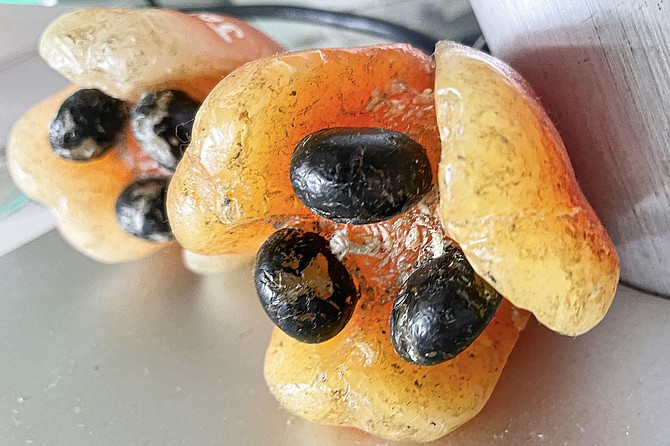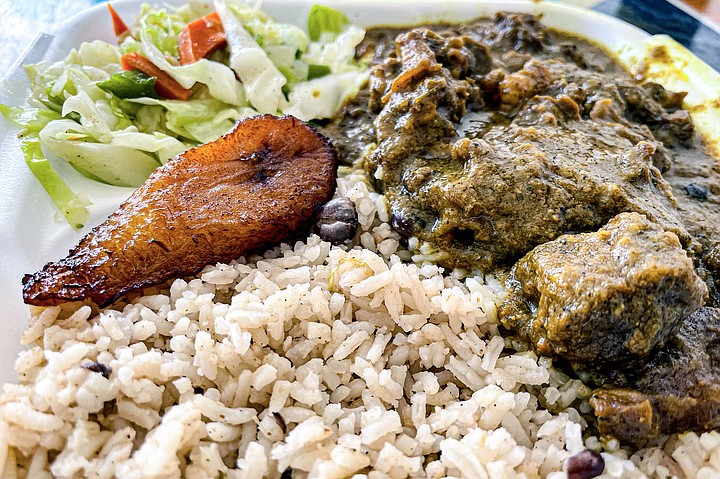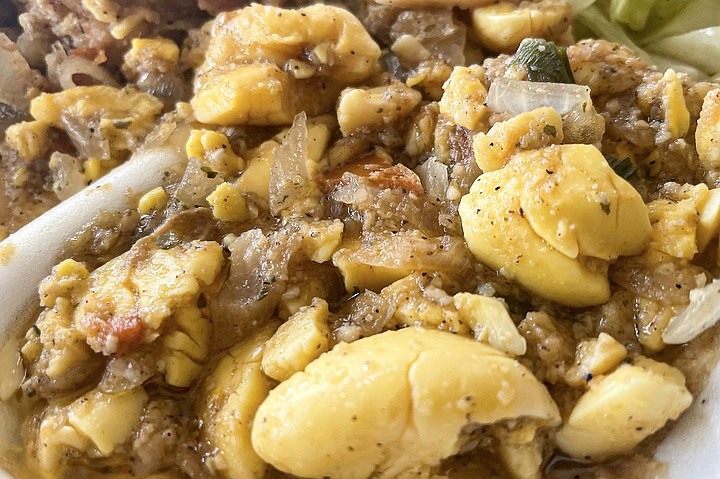 Facebook
Facebook
 X
X
 Instagram
Instagram
 TikTok
TikTok
 Youtube
Youtube

Jerk chicken, goat curry, oxtail, brown stew. Having spent fifteen years sampling dishes from at least that many Jamaican restaurants, I’ve come to view these as staples of the island cuisine built upon the pleasures of scotch bonnet peppers and allspice. But I’ve been missing one dish in particular, and it’s a big one: ackee and saltfish. The combo is important enough to be called the national dish of Jamaica, yet it often turns up missing from several local menus.

Part of the reason is built into the dish’s name: ackee fruit. The ackee tree, native to West Africa, grows in abundance on Jamaica, where it’s likewise celebrated as the national fruit. However, ackee fruit imports have been banned by the FDA, off and on over the years. It’s my understanding the raw fruit remains disallowed, while canned or frozen ackee fruit is okay.
The rationale behind banning it is that the red fruit — a relative of the lychee — contains harmful toxins until it’s ripe. Which sounds scary, except ackee fruit offers an unmistakable signal when it does ripen: it spreads opens like a flower, displaying a cluster of large, shiny, black seeds. The edible part is the starchy-looking white flesh surrounding those seeds.

Of the handful of San Diego area restaurants offering ackee and saltfish, one in particular puts the dish front and center: The Ackee Tree restaurant in City Heights. Opened by a native Jamaican cooking family recipes, the small counter shop has been open six years, and I’ve spent the past several days kicking myself for not trying it sooner.
Not only has Ackee Tree given me a chance to try something new (which I greatly appreciate), its jerk chicken ($11.50 small/$13 large) stands among the best I’ve tried. The classic jerk sauce get a boost from the smokey charcoal flavor of an outdoor grill, compelling a primal mmm with each bite. I’ve yet to try another house specialty — the oxtail ($$17/$21) — but the goat curry ($15/ $17) is likewise on the money. Swimming within the greenish curry, I found a the occasional whole pimenta, what Jamaicans call the allspice berry. It’s similar to a black peppercorn, but tasting like every holiday spice rolled into one.

Already I liked the place, but I would need to return for the ackee and saltfish. Apparently, the dish is served from breakfast through dinner in Jamaica, and from what they told me at Ackee Tree, the kitchen makes a certain amount in the morning, and serves til it sells out.
I did wonder about saltfish as a breakfast food, at first. Ackee Tree makes it with small bit of cod, sauteed with tomatoes and onions and spices. What makes it feel breakfast is the ackee itself. Though the flesh of the flower resembles small bits of banana, diced into this dish it takes on the texture of a particularly creamy (not crumbly) boiled egg yolk, or of the tofu in a Korean soft tofu stew.
It tastes neither like an egg, nor a fruit. The ackee flavor is quite mild, so it takes on the combined salt and acidity of the fish and veggies. The dish ain’t pretty — at best it looks like the quickly assembled scramble of a roadside diner. But the flavors and textures give it life rarely found on the side of the highway. And I’m still here, still typing, so the FDA has no cause for concern.


Jerk chicken, goat curry, oxtail, brown stew. Having spent fifteen years sampling dishes from at least that many Jamaican restaurants, I’ve come to view these as staples of the island cuisine built upon the pleasures of scotch bonnet peppers and allspice. But I’ve been missing one dish in particular, and it’s a big one: ackee and saltfish. The combo is important enough to be called the national dish of Jamaica, yet it often turns up missing from several local menus.

Part of the reason is built into the dish’s name: ackee fruit. The ackee tree, native to West Africa, grows in abundance on Jamaica, where it’s likewise celebrated as the national fruit. However, ackee fruit imports have been banned by the FDA, off and on over the years. It’s my understanding the raw fruit remains disallowed, while canned or frozen ackee fruit is okay.
The rationale behind banning it is that the red fruit — a relative of the lychee — contains harmful toxins until it’s ripe. Which sounds scary, except ackee fruit offers an unmistakable signal when it does ripen: it spreads opens like a flower, displaying a cluster of large, shiny, black seeds. The edible part is the starchy-looking white flesh surrounding those seeds.

Of the handful of San Diego area restaurants offering ackee and saltfish, one in particular puts the dish front and center: The Ackee Tree restaurant in City Heights. Opened by a native Jamaican cooking family recipes, the small counter shop has been open six years, and I’ve spent the past several days kicking myself for not trying it sooner.
Not only has Ackee Tree given me a chance to try something new (which I greatly appreciate), its jerk chicken ($11.50 small/$13 large) stands among the best I’ve tried. The classic jerk sauce get a boost from the smokey charcoal flavor of an outdoor grill, compelling a primal mmm with each bite. I’ve yet to try another house specialty — the oxtail ($$17/$21) — but the goat curry ($15/ $17) is likewise on the money. Swimming within the greenish curry, I found a the occasional whole pimenta, what Jamaicans call the allspice berry. It’s similar to a black peppercorn, but tasting like every holiday spice rolled into one.

Already I liked the place, but I would need to return for the ackee and saltfish. Apparently, the dish is served from breakfast through dinner in Jamaica, and from what they told me at Ackee Tree, the kitchen makes a certain amount in the morning, and serves til it sells out.
I did wonder about saltfish as a breakfast food, at first. Ackee Tree makes it with small bit of cod, sauteed with tomatoes and onions and spices. What makes it feel breakfast is the ackee itself. Though the flesh of the flower resembles small bits of banana, diced into this dish it takes on the texture of a particularly creamy (not crumbly) boiled egg yolk, or of the tofu in a Korean soft tofu stew.
It tastes neither like an egg, nor a fruit. The ackee flavor is quite mild, so it takes on the combined salt and acidity of the fish and veggies. The dish ain’t pretty — at best it looks like the quickly assembled scramble of a roadside diner. But the flavors and textures give it life rarely found on the side of the highway. And I’m still here, still typing, so the FDA has no cause for concern.
Comments